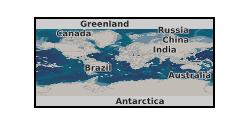University of Tokyo
Type of resources
Topics
Keywords
Contact for the resource
Provided by
Years
Formats
Representation types
Update frequencies
Resolution
-

To quantify the impact of leaked CO2 purposefully stored in subsea geological formations on the marine ecosystem, CO2 gas was injected into sandy sediments in a small bay in Scotland in 2012. Alongside the experiment, a numerical study was conducted to predict CO2 fate in the bay. CO2 may take the form both of the gas and dissolved phases when it seeps out from the seafloor. The bubble CO2 rises in the water column forming bubble plumes and dissolves into the seawater during its ascent. Measurements indicated that approximately 8–15% of the injected CO2 escaped the sediments in the gas phase and no empirical evidence was seen for fluxes in the dissolved phase. Therefore, it is thought that 85–92% of the CO2 remained within the sediments. However, the results of our numerical study suggest that 10–40% of the injected CO2 stayed in the sediment. Apart from unexpected errors in the present numerical simulation, a possible explanation for this discrepancy may be the heterogeneous nature of the sediment and observations limited in time and space. It is also recognised that the CO2 concentration away from the injection site is undetectably small and that the readily detectable signal is confined to a small area in the vicinity of the injection point. This is a publication in QICS Special Issue - International Journal of Greenhouse Gas Control, Chiaki Mori et. al. Doi:10.1016/j.ijggc.2014.11.023.
-
This dataset contains fluvial flood maps of the present day 1 in 20 year return period, and corresponding flood extents for 3 SSP (Shared Socioeconomic Pathway)/RCP(Representative Concentration Pathway) scenarios for the future (2070-2100). Change in flood return periods are estimated using CMIP6 projections and subsequently used to extract flood maps from a global flood model. Full details about this dataset can be found at https://doi.org/10.5285/0d5d69ae-7f50-40ee-a0c9-2522de138f27
-
Modelled annual average production loss (thousand tonnes per 1 degree by 1 degree grid cell) due to ground-level ozone pollution is presented for the crops maize (Zea mays), rice (Oryza sativa), soybean (Glycine max) and wheat (Triticum aestivum), for the period 2010-2012. Data are on a global scale, based on the distribution of production for each crop, according to the Food and Agriculture Organisation’s (FAO) Global Agro-Ecological Zones (GAEZ) crop production data for the year 2000. Modelled ozone data (2010-2012) needed for production loss calculations were derived from the EMEP MSC-W (European Monitoring and Evaluation Programme, Meteorological Synthesising Centre-West) chemical transport model (version 4.16). Mapping the global crop production losses due to ozone highlights the impact of ozone on crops and allows areas at high risk of ozone damage to be identified, which is a step towards mitigation of the problem. The production loss calculations were done as part of the NERC funded SUNRISE project (NEC06476) and National Capability Project NC-Air quality impacts on food security, ecosystems and health (NEC05574). Full details about this dataset can be found at https://doi.org/10.5285/0aa7911a-ab5f-4b08-a225-28b1e8344d01
-
A Yield Constraint Score (YCS; scale of 1-5) was developed for the effect of five key crop stresses (ozone, pests and diseases, soil nutrients, heat stress and aridity) on the production of the crops maize (Zea mays), rice (Oryza sativa), soybean (Glycine max) and wheat (Triticum aestivum). Data are on a global scale at 1 deg by 1deg resolution, based on the distribution of production for each crop, according to the Food and Agriculture Organisation’s (FAO) Global Agro-Ecological Zones (GAEZ) crop production data for the year 2000. To derive the YCS for each crop stress, spatial data on a global scale were gathered. Modelled ozone data (2010-2012) were derived from the EMEP MSC-W (European Monitoring and Evaluation Programme, Meteorological Synthesising Centre-West) chemical transport model (version 4.16). Pests and diseases data (2002-2004) were downloaded from a Centre for Agriculture and Biosciences International (CABI) database providing estimates for pre-harvest crop losses due to weeds, animal, pathogens and viruses, compiled from the literature. Soil nutrient classifications (for 2009, derived using soil attributes from the Harmonized World Soil Database (HWSD)) were downloaded from the GAEZ data portal. A heat stress index was calculated using daily temperature data (1990-2014) to determine whether the temperature within a 30-day thermal-sensitive period exceeded crop tolerance thresholds. Global Aridity Index data (1950-2000) were downloaded from the Consultative Group for International Agricultural Research’s Consortium for Spatial Information (CGIAR-CSI). The Yield Constraint Score provides an indication of where each stress is predicted to be affecting crop yield globally and the magnitude of the effect. The YCS data were developed as part of the NERC funded SUNRISE project and the National Capability Project NC-Air quality impacts on food security, ecosystems and health. Full details about this dataset can be found at https://doi.org/10.5285/d347ed22-2b57-4dce-88e3-31a4d00d4358
-
[This dataset is embargoed until October 1, 2024]. The Reference Observatory of Basins for INternational hydrological climate change detection (ROBIN) dataset is a global hydrological dataset containing publicly available daily flow data for 2,418 gauging stations across the globe which have natural or near-natural catchments. Metadata is also provided alongside these stations for the Full ROBIN Dataset consisting of 3,060 gauging stations. Data were quality controlled by the central ROBIN team before being added to the dataset, and two levels of data quality are applied to guide users towards appropriate the data usage. Most records have data of at least 40 years with minimal missing data with data records starting in the late 19th Century for some sites through to 2022. ROBIN represents a significant advance in global-scale, accessible streamflow data. The project was funded the UK Natural Environment Research Council Global Partnership Seedcorn Fund - NE/W004038/1 and the NC-International programme [NE/X006247/1] delivering National Capability Full details about this dataset can be found at https://doi.org/10.5285/3b077711-f183-42f1-bac6-c892922c81f4
 NERC Data Catalogue Service
NERC Data Catalogue Service